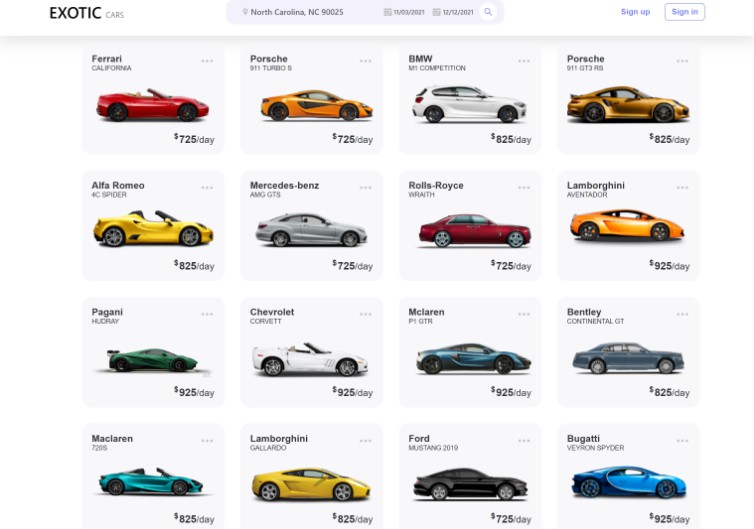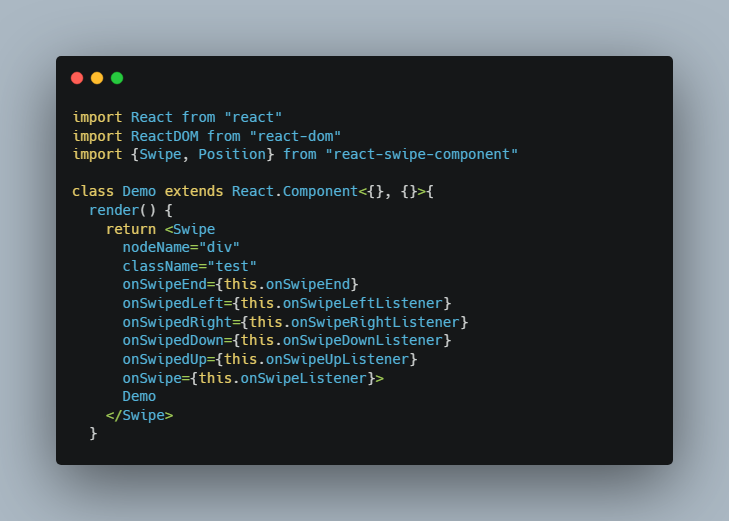React Swipeable
React swipe component - Swipe bindings for react.
Installation
$ npm install --save react-swipeable
Use
import Swipeable from 'react-swipeable'
class SwipeComponent extends React.Component {
swiping(e, deltaX, deltaY, absX, absY, velocity) {
console.log("You're Swiping...", e, deltaX, deltaY, absX, absY, velocity)
}
swipingLeft(e, absX) {
console.log("You're Swiping to the Left...", e, absX)
}
swiped(e, deltaX, deltaY, isFlick, velocity) {
console.log("You Swiped...", e, deltaX, deltaY, isFlick, velocity)
}
swipedUp(e, deltaY, isFlick) {
console.log("You Swiped Up...", e, deltaY, isFlick)
}
render() {
return (
<Swipeable
onSwiping={this.swiping}
onSwipingLeft={this.swipingLeft}
onSwiped={this.swiped}
onSwipedUp={this.swipedUp} >
You can swipe here!
</Swipeable>
)
}
}
react-swipeable(<Swipeable>) generates a new React element(<div> by default) under the hood and binds touch events to it that are used to fire the swiping and swiped props.
Props / Config Options
Event Props
onSwiping, onSwipingUp, onSwipingRight, onSwipingDown, onSwipingLeft, are called with the event
as well as the absolute delta of where the swipe started and where it's currently at. These constantly fire throughout touch events.
onSwiping in addition to the swipe delta, onSwiping also returns the current absolute X and Y position, as well as the current velocity of the swipe. this.props.onSwiping(e, deltaX, deltaY, absX, absY, velocity)
onSwipedUp, onSwipedRight, onSwipedDown, onSwipedLeft are called with the event
as well as the x distance, + or -, from where the swipe started to where it ended. These only fire at the end of a touch event.
onSwiped is called with the event, the X and Y delta, whether or not the event was a flick, and the current velocity of the swipe. this.props.onSwiped(e, deltaX, deltaY, isFlick, velocity)
onTap is triggered when a tap happens, specifically when a swipe/touch moves less than the delta. Is called with the onTouchEnd event this.props.onTap(e)
Configuration Props
flickThreshold is a number (float) which determines the max velocity of a swipe before it's considered a flick. The default value is 0.6.
delta is the amount of px before we start firing events. Also affects how far onSwipedUp, onSwipedRight, onSwipedDown, and onSwipedLeft need to be before they fire events. The default value is 10.
preventDefaultTouchmoveEvent is whether to prevent the browser's touchmove event. Sometimes you would like the target to scroll natively. The default value is false.
- Notes
e.preventDefault()is only called whenpreventDefaultTouchmoveEventistrueand the user is swiping in a direction that has an associated directionalonSwipingoronSwipedprop.- Example: user is swiping right with
<Swipable onSwipedRight={this.userSwipedRight} preventDefaultTouchmoveEvent={true} >thene.preventDefault()will be called, but if user was swiping lefte.preventDefault()would not be called. - Please experiment with example to test
preventDefaultTouchmoveEvent. swipeableversions <4.2.0- Chrome 56 and later, warning with preventDefault
- Example: user is swiping right with
stopPropagation automatically calls stopPropagation on all 'swipe' events. The default value is false.
nodeName is a string which determines the html element/node that this react component binds its touch events to then returns. The default value is 'div'.
trackMouse will allow mouse 'swipes' to additonally be tracked(click, hold, move, let go). See #51 for more details. The default value is false.
disabled will disable <Swipeable>: swipes will not be tracked and this stops current active swipes from triggering anymore prop callbacks. The default value is false.
innerRef will allow access to the Swipeable's inner dom node element react ref. See #81 for more details. Example usage <Swipeable innerRef={(el) => this.swipeableEl = el} >. Then you'll have access to the dom element that Swipeable uses internally.
rotationAngle will allow to set a rotation angle, e.g. for a four-player game on a tablet, where each player has a 90° turned view. The default value is 0.
None of the props are required.
PropType Definitions
Event Props:
onSwiped: PropTypes.func,
onSwiping: PropTypes.func,
onSwipingUp: PropTypes.func,
onSwipingRight: PropTypes.func,
onSwipingDown: PropTypes.func,
onSwipingLeft: PropTypes.func,
onSwipedUp: PropTypes.func,
onSwipedRight: PropTypes.func,
onSwipedDown: PropTypes.func,
onSwipedLeft: PropTypes.func,
onTap: PropTypes.func,
Config Props:
flickThreshold: PropTypes.number, // default: 0.6
delta: PropTypes.number, // default: 10
preventDefaultTouchmoveEvent: PropTypes.bool, // default: false
stopPropagation: PropTypes.bool, // default: false
nodeName: PropTypes.string // default: div
trackMouse: PropTypes.bool, // default: false
disabled: PropTypes.bool, // default: false
innerRef: PropTypes.func,
rotationAngle: PropTypes.number // default: 0
Development
Initial set up, with node 8+, run npm install.
Make changes/updates to the src/Swipeable.js file.
Before creating a PR please run npm test to make sure the tests and lint pass.
- Please add tests if PR adds/changes functionality.
Test changes/updates with the examples
Build, run, and test examples locally:
npm run start:examples
After the server starts you can then view the examples page with your changes at http://localhost:3000.
You can now make updates/changes to src/Swipeable.js and webpack will rebuild, then reload the page so you can test your changes!





